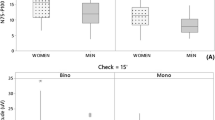Abstract
Purpose
To determine whether binocular summation in visual evoked cortical potential (VEP) is present in patients who have significantly different P100 peak latencies in their two eyes.
Methods
Twelve patients with unilateral optic neuritis (ON) and 11 normal controls were studied. All of them had visual acuity of ≥20/20 in both two eyes and good stereoacuity. Transient and steady-state VEPs were recorded with monocular and binocular pattern-reversal stimulation.
Results
In normal controls, the binocular summation ratio was 1.05 with transient stimulation and 1.21 with steady-state stimulation, and in ON patients it was 1.19 and 1.30, respectively. In ON patients, the peak latency of P100 components was delayed significantly when the affected eye was stimulated, but with binocular stimulation the waveform was very similar to that when the fellow eye was stimulated.
Conclusion
Binocular summation of VECP is not present in ON cases with large differences in the peak latency between the two eyes even if they have good stereoacuity. Binocular summation may not be correlated with stereopsis in adults whose binocular function has already matured.





Similar content being viewed by others
References
Adachi-Usami E, Lehmann D (1982) Scalp field topography of monocular and binocular evoked potentials—upper and lower hemiretinal stimuli. Doc Ophthalmol Proc Ser 31:391–398
Adachi-Usami E, Lehmann D (1983) Monocular and binocular evoked average potential field topography: upper and lower hemiretinal stimuli. Exp Brain Res 50:341–346
Amigo G, Fiorentini A, Pirchio M, Spinelli D (1978) Binocular vision tested with visually evoked potentials in children and infants. Invest Ophthalmol Vis Sci 17:910–915
Apkarian PA, Nakayama K, Tyler CW (1981) Binocularity in the human visual evoked potentials: facilitation, summation and suppression. Electroenceph Clin Neurophysiol 51:32–48
Giuseppe N, Andrea F(1983) Binocular interaction in visual-evoked response: summation, facilitation and inhibition in clinical study of binocular vision. Ophthalmic Res 15:261–264
Hely MA, McManis PG, Walsh JC, McLeod JG (1986) Visual evoked responses and ophthalmological examination in optic neuritis: A follow-up study. J Neurol Sci 75:275–283
Hubel DH, Wiesel TN (1978) Functional architecture of macaque monkey visual cortex. Proc R Soc Lond Ser B 198:1-59
Johansson B, Jakobsson P (1993) VEP latency – A comparison between normal and defective binocularity. Clin Vision Sci 3:245–251
Johansson B, Jakobsson P (2000) Fourier analysis of steady-state visual evoked potentials in subjects with normal and defective stereo vision. Doc Ophthalmol 101:233–246
Leguire LE, Rogers GL, Bremer DL (1991) Visual-evoked response binocular summation in normal and strabismic. Invest Ophthalmol Vis Sci 32:126–133
McCulloch DL, Skarf B (1991) Development of the human visual system: monocular and binocular pattern VEP latency. Invest Ophthalmol Vis Sci 32:2372–2381
Mitsuyu M, Yanashima K (1982) Binocular additivity of visually evoked cortical potentials in man. Doc Ophthalmol Proc Ser 31:421–426
Shea SL, Aslin RN, McCulloch D (1987) Binocular VEP summation in infants and adults with abnormal binocular histories. Invest Ophthalmol Vis Sci 28:356–365
Sloper JJ, Collins AD (1998) Reduction in binocular enhancement of the visual-evoked potential during development accompanies increasing stereoacuity. J Pediatr Ophthalmol 35:154–158
Sloper JJ, Garnham C, Gous P, Dyason R, Plunkett D (2001) Reduced binocular responses and stereoacuity in patients with Duane syndrome. Invest Ophthalmol Vis Sci 42:2826–2830
Srebro R (1978) The visually evoked response—binocular facilitation and failure when binocular vision is disturbed. Arch Ophthalmol 96:839–844
Wilson WB (1978) Visual-evoked responses differentiation of ischemic optic neuritis from the optic neuritis of multiple sclerosis. Am J Ophthalmol 86:530–535
Acknowledgments
The authors thank Duco I. Hamasaki (Bascom Palmer Eye Institute, Miami, Florida, USA) for his assistance and advice. This study was supported in a part by the Research Fund for Community Medicine, Japan and Grant-in Aid for scientific research from the Ministry of Education, Science, Sports and Culture, Japan (15591843).
Author information
Authors and Affiliations
Corresponding author
Rights and permissions
About this article
Cite this article
Mizota, A., Hoshino, A., Adachi-Usami, E. et al. Binocular summation in visual evoked cortical potential in patients who have significantly different P100 peak latencies in their two eyes. Graefe's Arch Clin Exp Ophthalmol 242, 762–766 (2004). https://doi.org/10.1007/s00417-004-0899-6
Received:
Revised:
Accepted:
Published:
Issue Date:
DOI: https://doi.org/10.1007/s00417-004-0899-6




